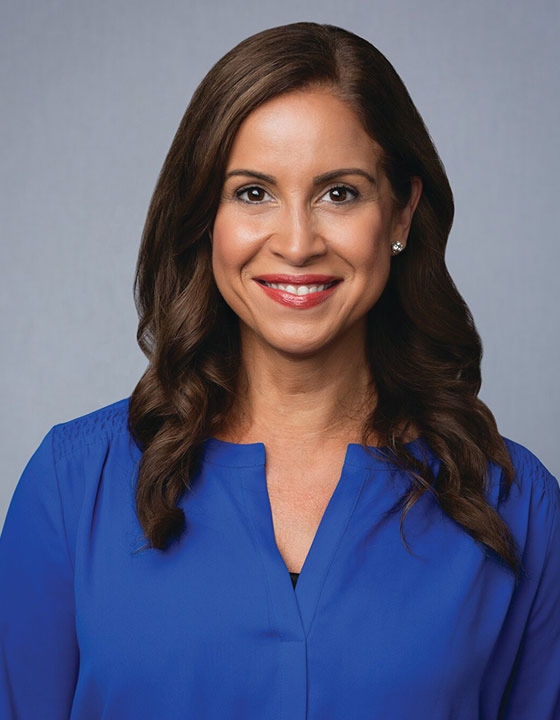American Public Schools in Crisis – Part II
- News & Events
- News
- American Public Schools in Crisis – Part II

In Part II of this Q&A, alumna Yanaiza Gallant discusses the massive teacher shortage and what real education reform could look like.

Alumna Yanaiza Gallant ’98, ’02, M.Ed. ’12 represents the best among Rhode Island teachers. She has devoted her career to working in some of the highest poverty areas in Rhode Island and has achieved record success in improving student achievement in every school she’s worked in.
In Part II of “American Public Schools in Crisis,” Gallant discusses the massive teacher shortage, noting how COVID-19 not only disrupted student learning but resulted in an increase in mental health issues among students. She points to systemic problems within the American education system and demonstrated, as principal, what real education reform could look like.
A 2022 research report found that there are at least 36,000 vacant teaching positions nationally, along with at least 163,000 positions being held by underqualified teachers. Why is there such a teacher shortage?
Twenty years ago, everybody wanted to be a teacher because it was respected. Today, teachers are expected to be all things to all people, and we just can’t do it. We lack the resources and the needed supports.
You may be teaching in a school with 350 students and only one social worker – if you’re lucky. We are seeing mental health issues like we’ve never seen before. What do you do with that when you have only one social worker for over 300 students? All you’re doing is being reactive and putting out fires, but you’re never going to be able to alleviate any of the behavioral problems. We need to reconsider social services within our school settings, yet it’s usually the first thing to get cut though it’s the thing that’s most needed. And we need to consider adding mental health professionals to our budgets.
When teachers say they are burnt out, I fully understand how they feel. In the same way that a parent puts their head down on the kitchen table and says, “I don’t know what to do. I feel helpless,” teachers feel that way 26 times for all 26 of the students in their class whom they don’t have the capacity to help. Many educators leave the field because they start to feel inadequate, they start to feel that they can’t do anything about the problems. They went into the profession to help, but they start to feel that the entire load is on their shoulders, they see things getting worse, they start to question their ability to help.
We need to bring respect back to the profession. We need to respect what educators do and what they are expected to accomplish.
Are teacher salaries a contributing factor to the teacher shortage?
I will always advocate for increasing educators’ salaries. I believe Rhode Island teachers fare well; however, there are teachers in the South who are working two to three part-time jobs to pay their rent. Fortunately, we’re not at that place here. In Rhode Island we can make a livable wage.
Ultimately, we don’t enter this profession for the money. Teaching is not a job; it’s a calling. We go into it because we love it, which is why I say if you bring respect back into the profession, you’re going to see retention look very different. We love the role, we love the field, we know it’s needed, but we also understand that we can’t do it alone. We need to experience positive mental and physical health and we need to have infrastructures and policies in place that support our work rather than place obstacles in our path.
Can you talk about the problems specific to urban school districts, where teacher burnout is particularly high?
The American school system has been built on the oppression of marginalized people. It’s in our history. Urban schools are dealing with drastic and dire deficiencies. They are dealing with poverty, inadequate housing and health inequities, all of which affect a student’s ability to learn. Urban schools are also dealing with inequities in how their schools are funded. There’s not enough funding to cover the needs of their students, leading to fewer resources for students and teachers and lack of access to critical programs and services.
There are also policies in place that put students behind. A student comes to this country who is not yet English proficient yet is made to take a math test to determine their grade level. If I were to go to another country where I didn’t speak the language and someone made me take a test like that, I would look very incompetent even though I am very intelligent. Yet this is one of our policies.
We have these amazing opportunities like free education, free resources, yet we don’t leverage them in an equitable way. We don’t use them to uplift people. I believe there is no such thing as an achievement gap, it's usually an opportunity gap because of the realities of systemic injustice.
You are also a strong proponent of using other means other than standardized tests to describe student success.
I’m all for collecting and analyzing data to understand where a child is in their development; however, we need to make sure that the tools we’re using also highlight a child’s strengths.
We rank a school’s success by stars. It’s almost like a Yelp review. Instead of pulling out stars, pull up the demographics. Look at this school that has predominantly multilingual learners and second language learners and look at the growth they’ve had. Currently, we use standardized test scores to measure proficiency and growth. How about using the student’s starting baseline to measure their growth?
If I have a fifth-grade student who entered our school at a first-grade proficiency, that student grew three years in one year. But because that student is a fifth-grade student and took a fifth-grade standardized test, they are not considered proficient. So, the three years of growth and all the interventions and all the hard work still count as a zero because they didn’t meet grade-level expectations. We really need to rethink the way we describe success in schools.
What would real education reform look like to you?
Real reform would focus on the whole child as opposed to a number. I had the luxury of being a principal at Orlo Avenue Elementary School in East Providence. It was called a “priority” school, a low-performing school. When I arrived, parents were pulling their kids out and taking them to another school. I gladly signed up to be principal because it was a challenge.
That first year I had to sit with the Rhode Island Department of Education and develop a plan for the first six months. I was asked, “How are you going to increase your proficiency rate on test scores?” I said, “That is not my focus right now.” I felt that if we didn’t build relationships with the community, creating a welcoming climate, and if we didn’t give opportunities for students to be the heart of the community, I don’t care if you’re an amazing teacher, kids don’t learn from people they don’t like and don’t trust.
Once I convinced our students and parents that they are welcomed, loved, cared for and respected, we flew. We got out of priority status in five years, which was unheard of. It took a belief system and an opportunity for the community to actually feel good about themselves. It took shifting the narrative from being a “bad school” to focusing on our greatness.
We moved from the bottom fifth percentile in the entire state to the 50th percentile. We had triple increases compared to our counterparts. We did the impossible. This experience was perhaps the highlight of my entire career. Personally, I would never work anywhere else but an urban school district. It’s where I was educated, it’s what I love and I want to pay it forward.
See “Alumna & Award-Winning Educator Explains Why American Public Schools are in Crisis – Part I”
